When purchasing a brisket you
can get a whole brisket with the
point or just a flat. In this
cook I went for the flat. Look for
grain running end to end if
possible. Diagonal is ok but try
and avoid the cuts with a hard
curve to the grain. Why? When it
comes time to cut the brisket
you want to cut across the
grain. This will produce pieces
of brisket that are easy to pull
apart and therefore chew. A
harsh curve to the grain and
parts of each cut will be tough
and others tender. We don't want
inconsistency. Aging of the meat
is a factor in tenderness as
well. now days it isn't as much
of an issue but I still like to
let that fabulous hunk of
protein hang out in the
refrigerator for a few days. If
anything, it help pump me up for
the big cook! After you purchase
your brisket let it sit in the
refrigerator for 3 days to age a
bit more.
The day before the cook rinse
I prepare my injection. In a pot
pour 2 cups Kitchen Basics beef
stock. Add 1/4 tsp Rosemary, 1/2
tsp Thyme, 1 Bay Leave, 3 cloves
coarsely chopped garlic, 1 tbsp
Worcestershire sauce and pepper
to taste. Stir contents and heat
on high until the stock comes to
a boil. Once it boils reduce
heat to low and simmer. Simmer
for 1 hour removing the Bay
leave after 20 minutes. Remove
from heat and let it cool. Once
cool, strain and refrigerate the
liquid stock. This will be used
the following morning as the
brisket injection.Early
morning of the cook I prepare
the brisket. Getting an early
start is key. Briskets take 1 to
1 /1/2 hours per pound to cook.
Rinse the brisket and pat dry.
Trim off excess fat cap. Leave a
little on if you wish but there
is no need to have 1/2 inch of
Fat cap between the smoke and
the meat.
Once
the brisket is cleaned and
trimmed, wipe down with yellow
mustard. This will allow the spices
and dry rub to adhere to the
brisket. Liberally coat with Mad
Hunky "No Sodium" rub.
Once the rub is on
sprinkle on some brown sugar and
rub into the brisket. Once both
sides are done insert two
toothpicks in the direction of
the grain. This will mark the
direction of the grain so when
it's time to slice the brisket
it will be easy to determine
direction. Next place the
brisket in the
refrigerator until a glaze forms.
Once glazed, it's time to
inject.
Using a flavor injector with a
sterile needle, inject every
three inches with beef stock. Push
plunger of flavor injector as
you withdraw the injector. This
will allow for good coverage.
Pre-Heat smoker to 230 degrees. Place brisket in
smoker.
Cook for 3 hours then mist with
beef stock from the carton of
Kitchen Basics. Cook until
brisket reaches 150 degrees.
Foil the brisket and pour the
left over stock over the meat
inside the foil. Wrap it up
good. Place back in the cooker
and continue to cook until the
brisket reaches 190 degrees.
Remove the brisket from the foil
and continue to cook until
brisket reaches 198 degrees.
This step I increase the temp to
275. You don't have to but it
helps dry the bark out a bit.
Once the brisket reaches 198
foil it and wrap it with a
towel. You will now let the
brisket rest for 30 to 40
minutes. While resting the
brisket will climb to about 203
degrees.
Once the brisket has rested,
it's time to trim. You want to
cut against or across the grain.
This will provide easier to chew
slices. The tooth picks mark the
direction of the grain.
The brisket should have a
nice thick pink smoke ring and
should be very tender. That's
it! Enjoy!
|
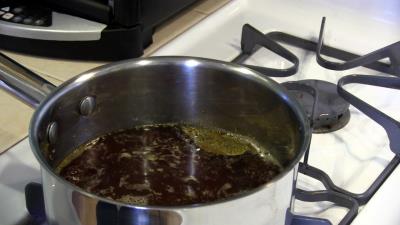
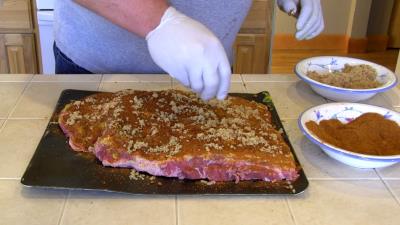
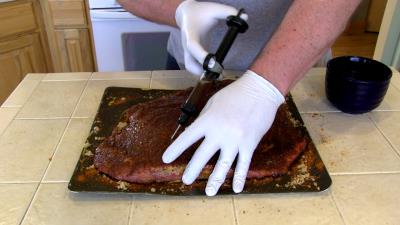
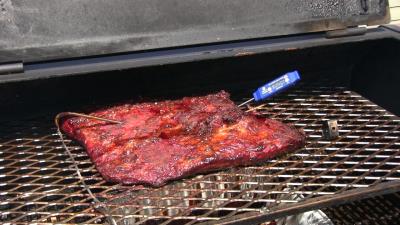
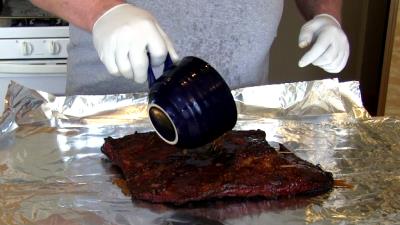
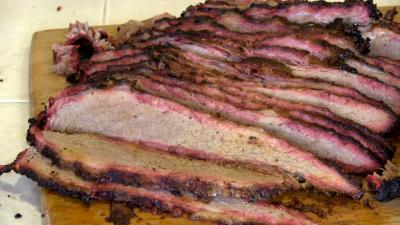
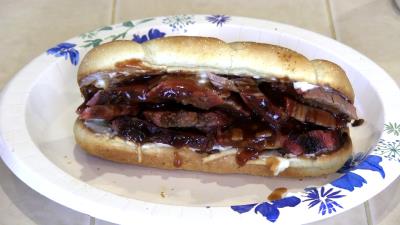
Header
Beef
Temperature Chart
|
Doneness |
Internal Temperature |
|
Rare
Medium-Rare
Medium
Medium-Well
Well Done |
140 Degrees
145 Degrees
150 Degrees
155 Degrees
160+ Degrees |
|